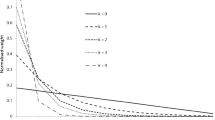Abstract
Two popular inequality measures used in the study of income and wealth distributions are the Gini (G) and Theil (T) indices. Several bounds on these inequality measures are available when only partial information about the distribution is available. However the correlation between them has been less studied. We derive the allowed region for the joint values of (G, T), for both continuous and discrete distributions. This has the form of a lower bound for T at given G. There is no corresponding upper bound, and T can be made as large as desired for given G by choosing an appropriate form of the Lorenz curve. We illustrate the bound for several parametric models of income distribution and Lorenz curves frequently used in the income distribution literature.


Similar content being viewed by others
References
Asada, Y.: Assessment of the health of Americans: the average health-related quality of life and its inequality across individuals and groups. Popul. Health Metr. 3, 7 (2005)
Atkinson, A.: On the measurement of inequality. J. Econ. Theory 2, 244–263 (1970)
Atkinson, A., Bourguignon, F.: Introduction: income distribution and economics. In: Atkinson, A., Bourguignon, F. (eds.) Handbook of Income Distribution, vol. 1, pp. 5–55. Elsevier, Amsterdam (2000)
Cerqueti, R., Ausloos, M.: Statistical assessment of regional wealth inequalities: the Italian case. Qual. Quant. 49, 2307–2323 (2015)
Chotikapanich, D.: A comparison of alternative functional forms for the Lorenz curve. Econ. Lett. 41, 129–138 (1993)
Cowell, F., Flachaire, E.: Statistical methods for distributional analysis. In: Atkinson, A., Bourguignon, F. (eds.) Handbook of Income Distribution, vol. 2. Elsevier, Amsterdam (2015)
Dragulescu, A., Yakovlenko, V.: Evidence for the exponential distribution of income in the USA. Eur. Phys. J. B Condens. Matter Complex Syst. 20, 585–589 (2001)
Gastwirth, J.: The estimation of the Lorenz curve and Gini index. Rev. Econ. Stat. 54, 306–316 (1972)
Gastwirth, J.: The estimation of a family of measures of economic inequality. J. Econ. 3, 61–70 (1975)
Gini, C.: Sulla misura della concentrazione e della variabilita dei caratteri. Premiate officine grafiche C Ferrari 73c, 1203–1248 (1914)
Gupta, M.: Functional form for estimating the Lorenz curve. Econometrica 52, 1313–1314 (1984)
Holm, J.: Maximum entropy Lorenz curves. J. Econ. 44, 377–389 (1993)
Kimura, K.: A micro-macro linkage in the measurement of inequality: another look at the Gini coefficient. Qual. Quant. 28, 83–97 (1994)
Marshall, A., Olkin, I., Arnold, B.: Inequalities-Theory of Majorization and Its Applications. Springer Series in Statistics. Springer, New York (2011)
Oancea, B., Andrei, T., Pirjol, D.: Income inequality in romania: the exponential-pareto distribution. Phys. A Stat. Mech. Appl. 469, 486–498 (2017)
Pereira, N., Salinas, P.: A relation between the Gini and Elteto measures of inequality. Qual. Quant. 12, 175–178 (1978)
Rohde, N.: Derivation of Theil’s Inequality Measure from Lorenz Curves Technical Report. University of Queensland, Brisbane (2007)
Ryu, H.: Maximum entropy estimation of density and regression functions. J. Econ. 56, 337–440 (1993)
Ryu, H.: Maximum entropy estimation of income distributions from Bonferroni indices. In: Chotikapanich, D. (ed.) Modeling Income Distribution and Lorenz Curves. Springer, New York (2008)
Schutz, R.: On the measurement of income inequality. Am. Econ. Rev. 41, 107–122 (1951)
Sun, T., Zhang, H., Wang, Y., Meng, X., Wang, C.: The application of environmental gini coefficient (egc) in allocating wastewater discharge permit: the case study of watershed total mass control in Tianjin, China. Resour. Conserv. Recycl. 54, 601–608 (2010)
Tao, Y., Wu, X., Zhou, T., Yan, W., Huang, Y., Yu, H., Mondal, B., Yakovlenko, V.M.: Exponential structure of income inequality: evidence from 67 countries. J. Econ. Interact. Coord. (2017). https://doi.org/10.1007/s11403-017-0211-6
Theil, H.: Economics and Information Theory. North Holland, Amsterdam (1967)
Vinod, T., Wang, Y., Fan, X.: Measuring education inequality—Gini coefficients of education. Working Paper Series 2525, The World Bank (2001)
Wittebolle, L., Marzorati, M., Clement, L., Balloi, A., Daffonchio, D., Heylen, K., De Vos, P., Verstraete, W., Boon, N.: Initial community evenness favours functionality under selective stress. Nature 458(7238), 623–626 (2009)
Author information
Authors and Affiliations
Corresponding author
Appendix: Proof of Proposition 1
Appendix: Proof of Proposition 1
The starting point of the proof is the following representation of the Theil index, which was given in Rohde (2007)
The Lorenz curve is defined in terms of the probability density function p(y) as
where x is the solution of \(\int _0^x p(y) dy = r\).
We would like to find the extremal values of the Theil index at constant Gini coefficient
This is a constrained variational problem over the space of the Lorenz curves L(r) with fixed points \(L(0)=0, L(1)=1\), satisfying the general properties of the Lorenz curve: i) increasing \(L'(r)\ge 0\), and ii) convex \(L''(r)\ge 0\).
The Gini coefficient constraint (28) is taken into account by introducing a Lagrange multiplier \(\alpha \) and studying the extremal points of the functional
Requiring the vanishing of the functional derivative \(\frac{\delta \Lambda }{\delta L} =0\) gives the Euler–Lagrange equation
The solution of this equation is
Imposing the boundary conditions \(L(0)=0,L(1)=1\) this gives the extremal Lorenz curve
This reproduces (5). The optimal function satisfies also the increasing and convexity properties so it is in the space of admissible Lorenz functions.
Substituting into the expressions of the Gini and Theil measures this gives also the relations (3) and (4). This completes the proof of Proposition 1.
Rights and permissions
About this article
Cite this article
Oancea, B., Pirjol, D. Extremal properties of the Theil and Gini measures of inequality. Qual Quant 53, 859–869 (2019). https://doi.org/10.1007/s11135-018-0792-8
Published:
Issue Date:
DOI: https://doi.org/10.1007/s11135-018-0792-8




